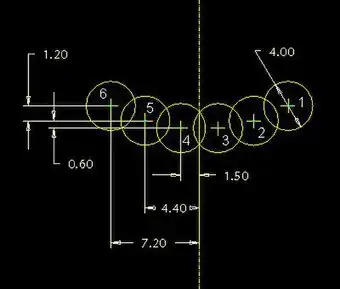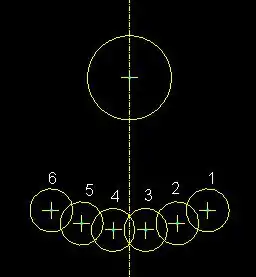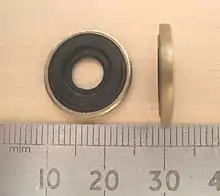
The Pin Index Safety System (PISS) is a means of connecting high pressure cylinders containing medical gases to a regulator or other utilization equipment. It uses geometric features on the valve and yoke to prevent mistaken use of the wrong gas. This system is widely used worldwide for anesthesia machines, portable oxygen administration sets, and inflation gases used in surgery.
Concept
The pin index safety system uses a face seal between the cylinder valve and the associated yoke clamp. There are two holes in specific positions on the cylinder valve body below the outlet port , in positions associated with the gas mixture, which prevent connection of the cylinder to a yoke or pressure regulator with a mis-matched set of pins. The holes accept pins 4 mm diameter by 6 mm long which are correctly aligned with the holes.[1]
Pin index configurations

Each gas cylinder has a pin configuration to fit its respective gas yoke. Refer to the diagram for pin numbers; dimensions are in millimeters.
- O2: 2,5[2][3][1]
- N2O: 3,5[2][3][1]
- Mixture of O2 and N2O (50% / 50%), commonly called Entonox: 7 (a single pin, located in the centre)
- Air: 1,5[3][1]
- Mixtures of CO2 and O2 with more than 7% CO2: 1,6[2]
- Mixtures of CO2 and O2 with less than 7% CO2: 2,6[2]
- He: No pin[1]
- Mixtures of O2 and He with less than 80% He, commonly called Heliox: 2,4[2]
- Mixtures of O2 and He with more than 80% He: 4-6[2]
- Cyclopropane: 3,6[2]
- Ethylene: 1,3[2]
- Nitrogen: 1,4[1]
 Pin index yoke connector for medical oxygen filling whip
Pin index yoke connector for medical oxygen filling whip Detail of pin index yoke connector for medical oxygen
Detail of pin index yoke connector for medical oxygen Pin index medical oxygen cylinder valve
Pin index medical oxygen cylinder valve
International Standards
- EN ISO 407 : Small medical gas cylinders - Pin-index yoke-type valve connections
The pin index system is a safety system (PISS) designed to ensure the correct gas is filled into the correct cylinder, and that the cylinder will only connect to the correct equipment. The positions of the holes on the cylinder valve correspond with the pins fitted to the yoke attached to the equipment. The pin positions for each medical gas are unique. If an attempt is made to fit the wrong gas cylinder to the yoke a tight seal will not be made, as the pins cannot locate.
The system requires a seal between the yoke and valve to prevent leakage. This is called a Bodok seal, and is a moulded rubber washer (or Neoprene) supported by a metal rim.[1]
Bodok seal

The Bodok seal is a specialised washer that ensures a gas-tight seal between the cylinder yoke or regulator of an anaesthetic machine or any medical device requiring a gas supply, and a gas cylinder. It was introduced along with the pin index safety system during the 1950s.
Attachment and detachment of a gas cylinder leads to constant wear and tear, due in part to mechanical distress and to gaseous compression and expansion. Adiabatic effects in rapidly expanding compressed gases can generate very low temperatures, necessitating a sufficiently durable and cold-resistant material such as neoprene. Prior to the introduction of the Bodok seal, the traditional fibre washer would frequently splay and cause leakage or adhere to the regulator, thus requiring the use of pliers and considerable force to remove it.
The Bodok seal consists of a neoprene washer with a peripheral metal reinforcing ring to prevent splaying. The seal is incombustible and resistant to the high pressures imposed upon it by cylinder gases, approximately 2,000 psi (140 bar) in a full cylinder.
Care must be taken when replacing gas cylinders that the Bodok seal does not stick to the cylinder valve face, and is thus 'lost' when the new cylinder is fitted, preventing a gas tight seal.
Bodok seals are also used in emergency oxygen kits used in first aid for underwater diving, but diving regulators used for scuba cylinders generally use a conventional o-ring seal with either a DIN 477 or CGA 850 yoke connector.
Limitations
It is possible to bypass the pin-index system if the pins are removed, damaged or corroded, if extra washers are used, or on some valves with a short face above the orifice, by inverting the gas cylinder. There is one report of the cylinder being painted the wrong colour leading to error.[4][5][6][7]
Alternative systems
Medical gas cylinders larger than size E (679 liters) are more likely to be fitted with threaded connectors. The connections used for larger cylinders vary widely among jurisdictions. One such system are the American CGA fittings.[8] In Europe there are British Standard (BS), German Standard (DIN) and French (AFNOR) connections, and Japan has the Japanese Standard (JIS).
Blanking Plugs
Blanking plugs (dummy cylinder heads) can be inserted into empty yokes to ensure that there is no leak out of the yoke when not in use.[9]
See also
- Diameter Index Safety System, used for lower pressure connections of medical gases
References
- 1 2 3 4 5 6 7 Srivastava, Uma (2013). "Anaesthesia gas supply: Gas cylinders". Indian Journal of Anaesthesia. 57 (5): 500–506. doi:10.4103/0019-5049.120147. PMC 3821267. PMID 24249883.
- 1 2 3 4 5 6 7 8 "Attaching Therapy Equipment: Pin Index Safety System" (PDF). Medical Gases and Safety Systems: CRC 330. Cardiorespiratory Care, University of South Alabama. Retrieved 12 August 2017.
- 1 2 3 Dosch, Michael P.; Tharp, Darin. "Supply system: Gases & electricity". The Anesthesia Gas Machine. University of Detroit. Retrieved 12 August 2017.
- ↑ Naithani, Udita; Betkekar, Sneha Arun; Verma, Devendra; Gehlot, Ravindra K; Sundararaj, Rajkumar (1 October 2016). "Pin index safety system and color coding: is it enough?". Ain-Shams Journal of Anaesthesiology. 9 (4): 626. doi:10.4103/1687-7934.198257. S2CID 136526015.
- ↑ Healy, Thomas EJ; Knight, Paul R. (31 October 2003). Wylie Churchill-Davidson's A Practice of Anesthesia 7th Edition. CRC Press. ISBN 9780340731307. Retrieved 13 August 2017.
- ↑ Goho, C.; Kittle, P. (July 1991). "Override of an N2O/O2 machine fail-safe mechanism: case report" (PDF). Pediatric Dentistry. 13 (4): 234–235. ISSN 0164-1263. PMID 1886828.
- ↑ Rawstron, R. E.; McNeill, T. D. (1 August 1962). "Pin Index System". British Journal of Anaesthesia. 34 (8): 591–592. doi:10.1093/bja/34.8.591. ISSN 0007-0912. Retrieved 13 August 2017.
- ↑ staff. "CGA Fitting Reference". www.concoa.com. Retrieved 12 August 2017.
- ↑ Davey, Andrew; Diba, Ali (2012). "4". Ward's anaesthetic equipment. Davey, Andrew J., Diba, Ali., Ward, C. S. (Crispian Stanley). (6th ed.). Edinburgh: Elsevier. p. 69. ISBN 9780702030949. OCLC 802047752.
External links
- Bodok seal note (See "Historical Forum" following "Nerve Plexus" article)